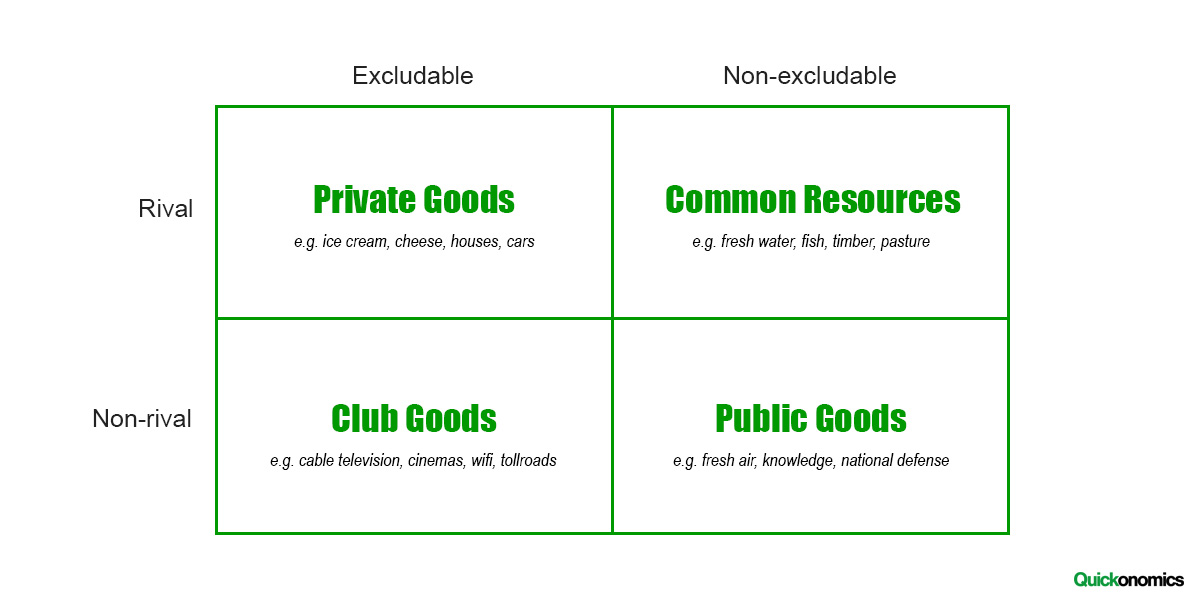Updated Feb 28, 2024 In microeconomics, goods can be categorized in many different ways. One of the most common distinctions is based on two characteristics: excludability and rivalrousness. That means we categorize goods depending on whether people can be prevented from consuming them (excludability) and whether individuals can consume them without affecting their availability to other consumers (rivalrousness). Based on those two characteristics, we can classify all physical products into four different types of goods: private goods, public goods, common resources, and club goods. We will look at each of them in more detail in the video and the paragraphs below. Private Goods are products that are both excludable and rival. They are generally sold to consumers at a certain price before they can be used. Thus, anyone who cannot afford to buy them (e.g., because their income is too low) is excluded from their consumption. Likewise, the consumption of private goods by an individual prevents other individuals from consuming the same goods. Therefore, private goods are also considered rival. Examples of private goods include ice cream, food, houses, cars, etc. In fact, most consumer goods you’ll come across in your daily life will be private goods. Public goods describe all products that are non-excludable and non-rival. That means no one can be prevented from consuming them, and consumers can use them without reducing their availability to other consumers. These types of goods are often supplied by the government and paid for with taxpayer money. Examples of public goods include fresh air, knowledge, national defense, street lighting, etc. Common resources are defined as products or resources that are non-excludable but rival. That means virtually anyone can use them. However, if one individual consumes them, their availability to other consumers is reduced. The combination of those two characteristics often results in an overuse of these resources because demand exceeds the available quantity (see also the tragedy of the commons). Examples of common resources include freshwater, fish, timber, pasture, etc. Club goods are products that are excludable but non-rival. Thus, individuals can be prevented from consuming them (i.e., access can be restricted), but their consumption does not reduce their availability to other individuals (at least not until a point of overuse or congestion is reached). Club goods are sometimes also referred to as artificially scarce resources. They are often provided by natural monopolies. Examples of this type of goods include cable television, cinemas, wireless internet, toll roads, etc. Technological advancements can lead to the reclassification of goods, particularly as digital goods and services become more prevalent. For example, software and online content, once considered public goods due to their non-excludability and non-rivalry, may move towards being club goods as access becomes more controlled and excludable through subscriptions and digital rights management. Government policies can significantly influence the provision and consumption of various goods. For instance, public goods like national defense are funded through taxation, while regulations and subsidies can affect the availability and demand for private and club goods, aiming to correct market failures or promote social welfare. Externalities impact the efficient allocation of common resources and public goods by causing overuse or underfunding, as individual actions do not account for societal costs or benefits. Solutions include government intervention through taxes, subsidies, and regulations to internalize externalities and the establishment of property rights to encourage responsible management and conservation of resources. There are four different types of goods in economics, which can be classified based on excludability and rivalrousness: private goods, public goods, common resources, and club goods. Private Goods are products that are excludable and rival. Public goods describe products that are non-excludable and non-rival. Common resources are defined as products or resources that are non-excludable but rival. And last but not least, club goods are products that are excludable but non-rival.Private Goods
Public Goods
Common Resources
Club Goods
Frequently Asked Questions (FAQs)
How do advancements in technology affect the classification of goods, especially with the rise of digital goods and services?
In what ways do government policies influence the provision and consumption of these different types of goods?
How do externalities impact the allocation and efficiency of common resources and public goods, and what solutions exist to address these challenges?
Summary

Microeconomics, Videos